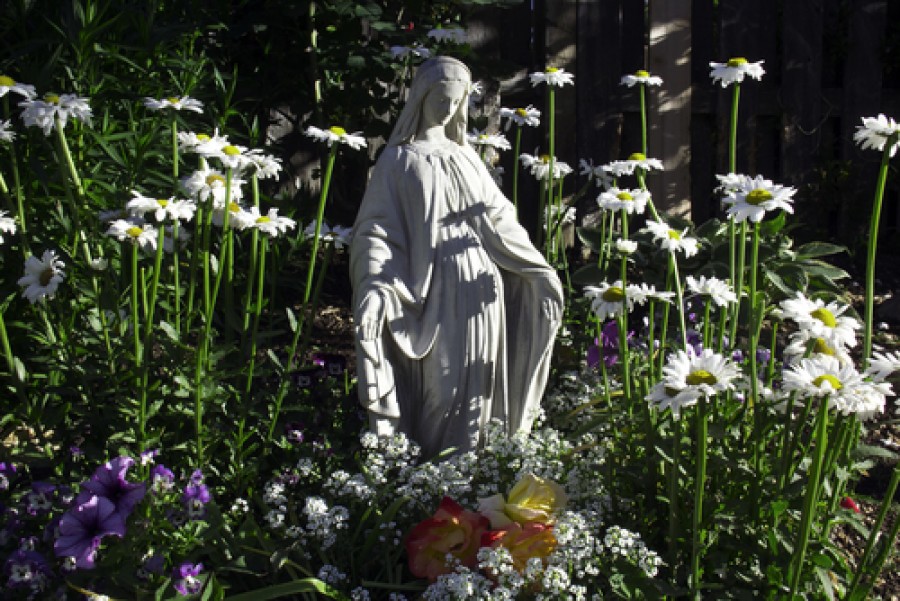For Beauty and Prayer Plant a Mary Garden
An easy way to honor our Blessed Mother, add beauty and pray at the same time

Gardening is among the most popular pastimes in the United States. But how many gardeners realize that all those marigolds they plant were originally called Mary’s Gold. Or that the pretty blue Bachelor Buttons were called Mary’s Crown. And the humble violet was once called Our Lady’s Modesty.
The early Christians, especially during the Middles Ages, knew not only the names but also the meanings behind the flowers. As they planted Mary Gardens, they knew larkspur stood for Our Lady’s Tears and cultivated herbs like rosemary symbolized Mary’s Bouquet.
Nature taught them spiritual lessons, just as many stained-glass windows in their churches taught them biblical lessons.
Flowers helped people meditate on Mary’s virtues and on her role with Jesus in the New Testament mysteries. One popular flower’s bouquets became a literal “Rose-ary.”
Today, Catholic gardeners can honor Our Blessed Mother in the same way. We can revere her in our yards and on our parish grounds when we plant a lovely Mary Garden.
They present endless possibilities because most all plants formerly had religious names and connections that are easy to rediscover, and the flowers' names and meanings are an absolutely beautiful way to meditate on Mary and Jesus and the New Testament while working in the garden or just enjoying its beauty.
Take the little wild pansy popularly called the Johnny-Jump-Up. Once I started to study Mary Gardens, I learned that in Middle Ages this colorful flower was known as the Herb Trinity.
Its bright tricolors of white, cream and purple (a reminder of Christ’s passion) symbolized the Trinity. Every time I see Johnny-Jump-Ups in my garden, I’m at once reminded of the Holy Trinity. Then, I learned these small flowers are also called Our Lady’s Delights, because at the Annunciation Mary was the first to learn the mystery of the Holy Trinity.
Of course, one should begin a Mary Garden with a statue of Our Lady.
May is perfect to being with annuals, with summer perennials ready to bloom and perennials that bloom in fall.
Flower and herb choices are practically limitless. The extensive website on Mary Gardens compiled over 50 years by John Stokes, which was given to the University of Dayton after he died, is a treasure house of articles, lists, history, photos, design ideas and book recommendations — probably the most comprehensive and extensive collection anywhere.
You can see the wonderful collection here.
To start, do you want to emphasize certain virtues of Our Lady, like her purity with the lily or humility with the violet, once called Our Lady’s Modesty?
Or concentrate on Our Sorrowful Mother with such plants as Lily of the Valley, once called Our Lady’s Tears. Legend has it her tears at the cross turned into these flowers.
Or choose flowers highlighting her motherly concern and protection for us from evil and harm, like Ladies Mantle (still called by the same name today as well as alchemilla), and the morning glory, also called Our Lady’s Mantle.
Do we want to sing Our Lady’s Praises (petunias) and greet her with Ave Maria (hydrangea)?
We can pick plants that help us meditate on the Holy Family. Legend has it that lavender (Mary’s Drying Plant) gained its fragrance when Mary placed Jesus’ clothes to dry on it. The same for rosemary.
Sea pinks and scabiosa (pincushion flower) are called Our Lady’s Pincushion, as they recall Mary’s family sewing.
How about zinnias (Little Mary) or flowers like celosia (Jesus Plant) for Mary’s Son and hollyhock (St. Joseph’s Staff) for her husband.
And cosmos, the St. Michael Flower, is special because the archangel was considered her main guardian angel.
Ever-popular impatiens are more meaningful in their older Marian name — Mother Love. Their continuous blooming represents Mary’s constant love.
Because of their curving stems, impatiens were also called Our Lady’s Earrings, since Mary heard the word of God and kept it.
Even strawberries were called Fruitful Virgin because they’re in flower and fruit at the same time, symbolic of Mary’s perpetual virginity.
Of course, the rose is Our Lady’s quintessential flower. Back in the 14th century, Dante called Mary “the Rose in which the Divine Word became flesh.”
She’s described in the Bible as “the Rose of Sharon” (there’s still the plant by the same name) and in the Litany of Loreto as “Mystical Rose.”
Because the rose is a very old symbol of Mary and her spiritual beauty and fragrance so pleasing to God, plant a rose bush is most appropriate. And pray the Rosary — which is a spiritual garden of roses for Mary.
For apartment dwellers without a yard, no problem. A Mary Dish Garden can be planted indoors or on a balcony. All it takes is a suitable container, a favorite small statue of Mary and some petite-scale flowers or herbs suited to indoors.
Even weeding can be pleasant if we think of the task as keeping neat the brilliant yellow circles of Mary’s Crown (today’s pot marigolds, recalling her queenship of heaven) and tidying the paths for her Lady Slippers.
Mary Gardens become a wonderful place of prayer. They’re wayside chapels in our own yards. Near a Mary Garden we might never pluck out a dandelion again — once called Mary’s Bitter Sorrow.
With a Mary Garden, we’ll never again think of marigolds or impatiens the same way.
And we’ll turn our gardening into a loving prayer to Our Lady.













